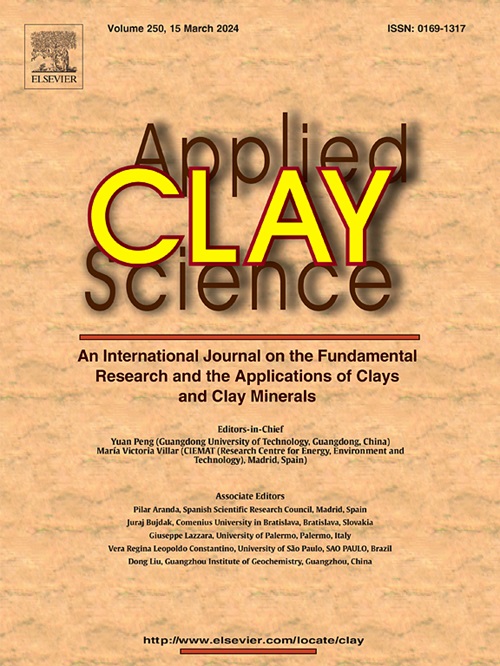Techniques for porewater extraction from clayrocks
IF 5.3
2区 地球科学
Q2 CHEMISTRY, PHYSICAL
引用次数: 0
Abstract
The chemical and isotopic composition of porewaters in clayrocks records the palaeo-hydrogeological evolution of sedimentary basins. However, porewater extraction is in general demanding and time-consuming. Techniques have been newly developed or adapted in recent years, and progress in analytical methods, in particular the minimisation of sample mass needed for analysis, have opened new opportunities for porewater studies. Depending on their degree of induration, clayrocks span a wide range of porosities. They all have in common a nanometric pore-space architecture, which results in low permeability and the predominance of diffusive solute transport through the formation. The negatively charged clay-mineral surfaces affect both the chemical composition and the binding state of the water molecules in the adjacent pore space. Thus, in a profile across a pore, the composition and the mobility of the porewater vary as a function of the distance from the clay surface. In a simplified way, two water types, namely free, charge-balanced porewater in the central parts of a pore and bound/interlayer water along clay surfaces can be distinguished.
Adequate field sampling protocols are needed to preserve core materials from evaporation and oxidation, and to this end well-trained on-site staff is a pre-requisite in order to minimise exposure of the samples to the atmosphere. Porewater extraction from clayrocks requires dedicated methods that are based on different physical principles, including the application of high hydraulic gradients (advective displacement, centrifugation, sampling of in-situ seepages), axial pressure (squeezing), diffusive equilibration (out-diffusion, isotope diffusive exchange, in-situ circulation tests), capillary suction (filter absorption), heating (vacuum distillation), crushing and dilution (aqueous extraction), and outgassing via diffusion (analysis of dissolved noble and reactive gases). Different extraction methods often yield consistent results, but distinct differences may occur if the methods sample different domains of the pore space. The attribution of water extracted by a specific method to a particular porewater reservoir is not always evident, and current research aims at a better understanding of this issue.
The suitability of a particular method depends on the properties of the studied clayrock (porosity, degree of cementation, mineralogy) and the parameters of interest (major ions, stable water isotopes, dissolved gases). Each method has its limitations and incurs various kinds of artefacts that may require corrections. It is concluded that there is no single best method to extract the porewater and to analyse the dissolved constituents and isotope composition, and that a method or combination of methods should be selected considering the properties of the studied clayrock.
粘土岩孔隙水提取技术
粘土岩孔隙水的化学和同位素组成记录了沉积盆地的古水文地质演化。然而,孔隙水提取通常要求高且耗时。近年来新开发或调整了技术,分析方法的进步,特别是分析所需样品质量的最小化,为孔隙水研究开辟了新的机会。根据其硬化程度,粘土岩的孔隙度范围很广。它们都有一个共同的纳米孔隙空间结构,这导致了低渗透率和溶质在地层中扩散传输的优势。带负电荷的粘土矿物表面影响相邻孔隙空间中水分子的化学组成和结合状态。因此,在穿过孔隙的剖面中,孔隙水的组成和流动性随距离粘土表面的距离而变化。简单地说,可以区分两种水类型,即孔隙中心部分的自由、电荷平衡的孔隙水和沿粘土表面的束缚水/层间水。需要充分的现场采样协议来保护核心材料免受蒸发和氧化,为此,训练有素的现场工作人员是先决条件,以尽量减少样品暴露于大气中。从粘土岩中提取孔隙水需要基于不同物理原理的专用方法,包括应用高水力梯度(平流位移、离心、原位渗流取样)、轴向压力(挤压)、扩散平衡(向外扩散、同位素扩散交换、原位循环试验)、毛细管吸力(过滤吸收)、加热(真空蒸馏)、破碎和稀释(水萃取)、通过扩散(分析溶解的惰性气体和活性气体)排出气体。不同的提取方法通常会产生一致的结果,但如果不同的方法采样不同的孔隙空间域,可能会出现明显的差异。通过特定方法提取的水对特定孔隙水储层的归属并不总是很明显,当前的研究旨在更好地理解这一问题。特定方法的适用性取决于所研究粘土岩的性质(孔隙度、胶结程度、矿物学)和感兴趣的参数(主要离子、稳定水同位素、溶解气体)。每种方法都有其局限性,并且会产生各种需要校正的伪影。结论认为,没有单一的最佳方法来提取孔隙水并分析溶解成分和同位素组成,应根据所研究粘土岩的性质选择一种或几种方法的组合。
本文章由计算机程序翻译,如有差异,请以英文原文为准。
求助全文
约1分钟内获得全文
求助全文
来源期刊

Applied Clay Science
地学-矿物学
CiteScore
10.30
自引率
10.70%
发文量
289
审稿时长
39 days
期刊介绍:
Applied Clay Science aims to be an international journal attracting high quality scientific papers on clays and clay minerals, including research papers, reviews, and technical notes. The journal covers typical subjects of Fundamental and Applied Clay Science such as:
• Synthesis and purification
• Structural, crystallographic and mineralogical properties of clays and clay minerals
• Thermal properties of clays and clay minerals
• Physico-chemical properties including i) surface and interface properties; ii) thermodynamic properties; iii) mechanical properties
• Interaction with water, with polar and apolar molecules
• Colloidal properties and rheology
• Adsorption, Intercalation, Ionic exchange
• Genesis and deposits of clay minerals
• Geology and geochemistry of clays
• Modification of clays and clay minerals properties by thermal and physical treatments
• Modification by chemical treatments with organic and inorganic molecules(organoclays, pillared clays)
• Modification by biological microorganisms. etc...
 求助内容:
求助内容: 应助结果提醒方式:
应助结果提醒方式:


